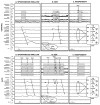Respiratory events in infants presenting with apparent life threatening events: is there an explanation from esophageal motility?
- PMID: 24681180
- PMCID: PMC4112005
- DOI: 10.1016/j.jpeds.2014.02.003
Respiratory events in infants presenting with apparent life threatening events: is there an explanation from esophageal motility?
Abstract
Objective: To test the hypothesis that proximal aerodigestive clearance mechanisms mediated by pharyngoesophageal motility during spontaneous respiratory events (SREs) are distinct in infants with apparent life threatening events (ALTEs).
Study design: Twenty infants (10 with proven ALTE, 10 healthy controls) had pharyngoesophageal manometry to investigate motility changes concurrent with respiratory events detected by respiratory inductance plethysmography and nasal thermistor methods. We measured changes in resting upper esophageal and lower esophageal sphincter pressures, esophageal peristalsis characteristics, and gastroesophageal reflux. Statistical analysis included mixed models; data presented as mean±SD, median (range), or percentage.
Results: Infants with ALTE (vs controls) had: (1) delays in restoring aerodigestive normalcy as indicated by more frequent (P=.03) and prolonged SREs (P<.01); (2) a lower magnitude of protective upper esophageal sphincter contractile reflexes (P=.01); (3) swallowing as the most frequent esophageal event associated with SREs (84%), with primary peristalsis as the most prominent aerodigestive clearance mechanism (64% vs 38%, P<.01); (4) a higher proportion of failed esophageal propagation (10% vs 0%, P=.02); and (5) more frequent mixed apneic mechanisms (P<.01) and more gasping breaths (P=.04).
Conclusions: In infants with ALTE, prolonged SREs are associated with ineffective esophageal motility characterized by frequent primary peristalsis and significant propagation failure, thus suggestive of dysfunctional regulation of swallow-respiratory junction interactions. Hence, treatment should not target gastroesophageal reflux, but rather the proximal aerodigestive tract.
Copyright © 2014 Elsevier Inc. All rights reserved.
Conflict of interest statement
The authors declare no conflicts of interest.
Figures



Comment in
-
Putting reflux to rest.J Pediatr. 2014 Aug;165(2):225-6. doi: 10.1016/j.jpeds.2014.02.060. Epub 2014 Mar 31. J Pediatr. 2014. PMID: 24698453 No abstract available.
References
-
- Pediatrics; National Institutes of Health Consensus Development Conference on Infantile Apnea and Home Monitoring; Sept 29 to Oct 1, 1986; 1987. pp. 292–9. - PubMed
-
- Doshi A, Bernard-Stover L, Kuelbs C, Castillo E, Stucky E. Apparent life-threatening event admissions and gastroesophageal reflux disease: the value of hospitalization. Pediatr Emerg Care. 2012;28:17–21. - PubMed
-
- Jadcherla SR, Durr B, Chan C, Slaughter J, Castile R, Klebanoff M. Characteristics of Infants Admitted with an Apparent Life Threatening Event (ALTE) in the Safe Sleep Era. PAS. 2013A
-
- Brooks JG. Apparent life-threatening events. Pediatrics in review/American Academy of Pediatrics. 1996;17:257–9. - PubMed
-
- Janvier A, Khairy M, Kokkotis A, Cormier C, Messmer D, Barrington KJ. Apnea is associated with neurodevelopmental impairment in very low birth weight infants. J Perinatol. 2004;24:763–8. - PubMed
Publication types
MeSH terms
Grants and funding
LinkOut - more resources
Full Text Sources
Other Literature Sources

